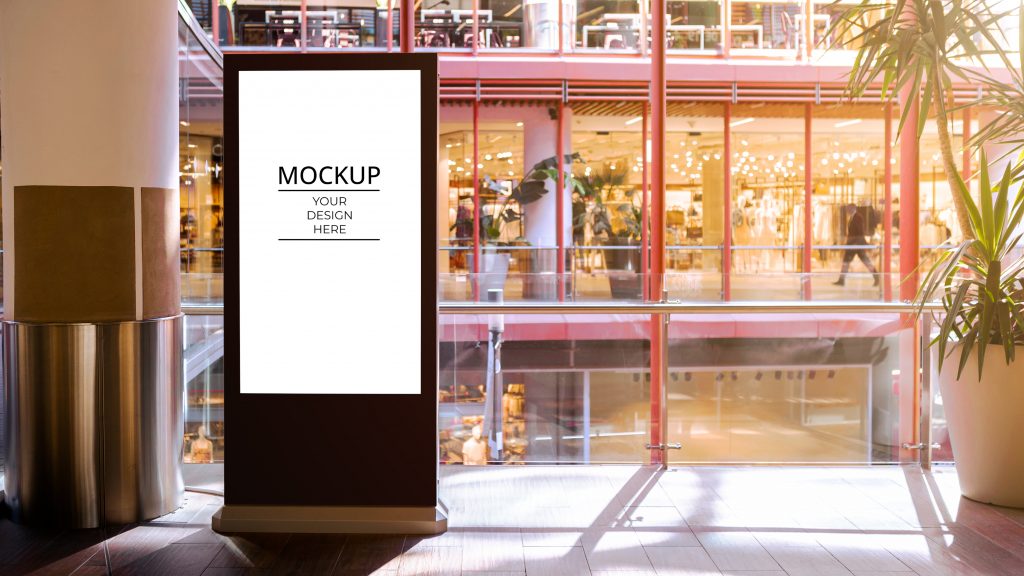The Evolution of Advertising in the Digital Age
· What is Digital Signage?
The use of digital displays, such as LCD panels, LED boards, or projection screens, to convey dynamic and customized content to a particular audience is referred to as digital signage. It entails the generation, management, and presentation of digital content on screens in public or private spaces.
Digital signage can be found in a variety of settings, including retail establishments, restaurants, airports, hotels, business offices, healthcare facilities, educational institutions, and transportation hubs. Its goal is to capture viewers’ attention, inform, entertain, or promote to them the business offerings in a visually appealing and interactive manner.
The content presented on digital signs can be customized and adaptive. It may include commercials, promotional messages, news updates, weather forecasts, social network feeds, event information, wayfinding directions, videos, photos, animations, or any other type of relevant digital material to the intended audience.
Digital signage network management often entails content generation, selection, scheduling, distribution, and monitoring. This can be accomplished through the use of specialized software or cloud-based platforms that provide remote management and control across multiple screens.
In general, digital signage is a contemporary and dynamic medium for communication, advertising, and information distribution in a variety of locations. Its adaptability, interactivity, and capacity to catch attention make it an excellent tool for engaging audiences and communicating messages visually.

- Enhancing Corporate Advertising with Digital Signage
Digital signage has evolved into an indispensable tool for improving corporate advertising methods. Here are some examples of how digital signage could boost business advertising:
Captivating Visuals: Digital signage enables businesses to present visually appealing content that attracts viewers’ attention and engages them. High-resolution screens, rich colours, animations, and videos can all be used to produce aesthetically engaging advertisements.
Dynamic Content: Digital signage, unlike conventional static signs, allows for real-time content transitions. Corporations can simply alter and schedule content remotely, allowing timely and appropriate notifications to be delivered. The flexibility is beneficial for organizations with multiple locations or those that need to promptly modify their messaging.
Cost Efficiency: While there may be some initial costs connected with establishing digital signage infrastructure, it can be cost-effective in the long term. Digital signage eliminates the need for traditional signage’s printing and delivery costs, and the ability to update material cuts continuing expenditures remotely. Furthermore, digital signage allows for content reuse, decreasing the requirement to create new materials from scratch.
Targeted Messaging: Corporations can use digital signage to convey particular marketing messages to specific audiences. Companies can modify their content based on demographics, location, or even real-time elements such as weather or time of day by activating audience data and analytics. Personalization improves the relevance and efficacy of marketing campaigns.
Interactive Experiences: Interactive components in digital signage allow viewers to engage directly with the content being displayed. To stimulate audience engagement, gather comments, or provide dynamic product demos, touchscreens, motion sensors, or QR codes can be used. These interactive experiences help to create an engaging and memorable advertising setting.
The Future of Corporate Advertising with Digital Signage
- Immersive Experiences with AR and VR Integration
- Augmented Reality (AR) Integration: AR overlays digital content over the real-world environment, increasing the viewer’s perception and engagement with the surroundings. Businesses may deliver interactive and immersive experiences by incorporating AR into digital signage. Viewers, for example, can use their smartphones or AR-enabled devices to scan QR codes displayed on digital signs to access extra information, product presentations, or even interactive games. AR integration offers a layer of interactivity and engagement, making the advertising experience enjoyable and appealing.
- Virtual Reality (VR) Integration: VR provides viewers with a truly realistic and virtual experience. By implementing VR into digital signage, businesses can lead viewers into virtual worlds and provide unique experiences. For example, VR headsets can be placed near digital signage, allowing users to explore virtual showrooms, take virtual tours of properties, or engage in immersive storytelling. VR integration allows businesses to develop engaging and effective advertising campaigns that stand out.
- Interactive Product Visualization: By incorporating AR and VR with digital signage, viewers can engage with virtual representations of products or services. Through interactive 3D models, they can virtually try on items, picture furnishings in their homes, and learn how a product works. This dynamic product visualization improves viewers’ comprehension and engagement, allowing them to make wiser purchasing decisions.

· Integration with Data Analytics and AI
1. Audience Insights: Businesses can gain important insights into their target audience by integrating data analytics and digital signage. Demographic information, audience involvement, and preferences can all be collected and analyzed. This data assists in better understanding the target audience and adapting the advertising content to their requirements and interests.
2. Real-time Customization: Data analytics and AI enable real-time control of digital signage content. AI algorithms can dynamically change the content to deliver more relevant and tailored advertisements by assessing viewer data, such as age, gender, or previous interactions. This improves the viewing experience and the effectiveness of advertising efforts.
3. Personalized Advertising: Corporations can send personalized pitches to individual viewers using AI algorithms and data analytics. AI can provide personalized suggestions and tailor content to unique viewer profiles by evaluating data on individual interests, purchase history, or surfing behaviour. This personalization improves the viewer’s experience while increasing the effectiveness of advertising campaigns.
Overcoming Challenges and Maximizing the Impact of Digital Signage
· Content Strategy and Management
Start by setting specific goals for your digital signage content. Determine the precise objectives you wish to achieve, such as raising brand awareness, marketing items, increasing sales, or improving relationships with customers.
Assess your target audience and generate content that resonates to them. Take into account their demographics, preferences, and interests. To ensure that your material attracts their attention and provides a compelling message, tailor it to their needs and tastes.
Invest in aesthetically appealing and high-quality material. Use compelling graphics, videos, animations, and typography to capture attention and effectively deliver your message. Check that your images are in line with your brand’s identity and messaging.
Maintain content uniqueness and originality by avoiding repetitive displays. Create a content rotation schedule to guarantee that visitors are exposed to new and relevant material on a regular basis. This keeps the content interesting and encourages repeat visits.
To schedule and manage your digital signage content, develop an effective content management system. Use content management tools or cloud-based systems to update and schedule material across various displays. This guarantees that content is delivered on time and in context.
· Technical Considerations
Select the appropriate hardware for your digital signage network. Consider display dimensions, resolution, brightness, connectivity choices, and durability. Choose screens and media players that are appropriate for the setting and can manage the content needs.
Ensure a dependable and resilient network infrastructure to support your digital signage network. High-speed internet access is required for continuous content updates and remote management. For optimal performance, evaluate bandwidth requirements and consider employing dedicated network connections or content delivery networks (CDNs).
Implement a user-friendly content management system (CMS) that enables simple content creation, scheduling, and delivery. The CMS should handle several media formats and allow for remote management. Take into account the essential features such as content templates, playlist management, and real-time content changes.
Choose the most effective way to deliver material to your digital signage displays. Local media players, cloud-based delivery, and streaming content from remote servers are all options. Select a content delivery option that is compatible with your network architecture, scalability needs, and content management preferences.
· Audience Engagement and Measurement
Monitor and analyze the performance of your digital signage content on a continuous basis. Keep an eye on indicators like audience engagement, dwell duration, conversion rates, and sales effect. Use data analytics to find patterns, insights, and opportunities for improvement.
Conduct surveys or collect feedback from viewers to have a better understanding of their perspectives and preferences. To gather feedback on the content, messaging, and overall experience, use on-screen prompts or digital signage kiosks. This data can help you optimize your digital signage approach and increase audience engagement. To find out what your audience responds to most favourably, test various layouts, images, text, or call-to-action (CTA)s.
Frequently Asked Question
· How does digital signage increase sales?
Product & Service Promotion: Digital signage displays offer a platform for showcasing products, highlighting promotions, and communicating exclusive deals. Digital signage can effectively sell products, elicit a sense of urgency, and persuade clients to make a purchase by presenting engaging graphics and convincing messaging. Real-time updates and dynamic content enable the timely promotion of new goods, special bargains, or deals that are only available for a limited time.
Upselling & Cross-selling: Digital signage can be used for upselling and cross-selling, which increase sales by suggesting additional or improved products. Digital display signage encourages customers to explore future purchases, increasing overall sales value. It achieves this by displaying related products or bundles, spotlighting customer favourites, or emphasizing limited-time discounts.
Personalization and Targeting: Digital signage advertising can provide tailored content depending on user preferences, behaviours, or demographics by integrating data analytics and AI. Digital signage is more relevant and successful at influencing purchasing decisions when messages and offers are tailored to particular audiences. Personalization raises consumer engagement and conversion chances, which ultimately results in more sales.
Customer insight gathering: Sensors or interactive features that collect customer information and input can be incorporated into digital signage. Businesses can improve their offerings, optimize their marketing tactics, and improve the entire customer experience by gaining insights into consumer interactions, dwell duration, or content preferences. Making decisions based on data can result in more informed choices and more sales.
Overall, digital signage improves the customer experience, encourages engagement, and ultimately increases sales for businesses by utilizing the power of focused messaging and visual communication.
GET ADVANTAGE OF BRANDBOY’S DIGITAL SIGNAGE SOLUTIONS
Brandboy Australia is an excellent choice if you’re looking for a dependable digital signage service provider or the best signage company in Sydney. We have a trusted network of skilled signage manufacturers and installers who have a track record of offering top-notch signage installation services. The Brandboy team has the capability to provide and install multiple signage displays at multi-site business locations. With the commitment to providing service on time and within budget, we can help you in transforming spaces that will make your business thrive.
Wayfinding, experiential architecture, graphic walls, digital display signs, indoor and outdoor digital signage, office signage, custom signs, and AR/VR displays are just a few of the digital signage solutions we provide. Across Australia, we have been successful in installing digital signage at retail and commercial business establishments, shopping malls, trade show locations, corporate offices, industrial sites, entertainment and hospitality venues, and public transportation infrastructure organizations.
Brandboy can link multi-site business facilities and establishments anywhere in Australia by using advanced technology and software programs that efficiently push content. The same local content can be distributed throughout your retail network. We also have the capacity to help you promote your products and services to third parties or business partners. Brandboy is willing to talk about your requirements for your current objectives and future goals.
Schedule a meeting with Brandboy to discuss how you can use digital signage Australia to offer your clients high-quality service. Contact us at 0451 816 788 or lars@brandboy.com.au immediately to learn more about our innovative digital signage solutions.

